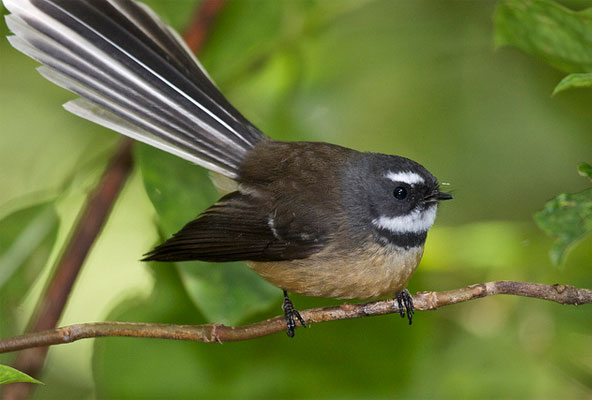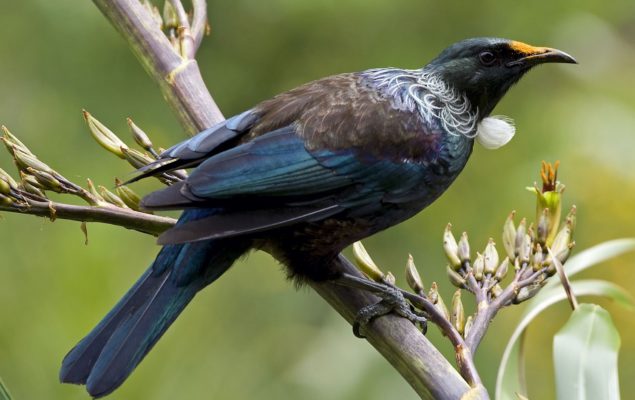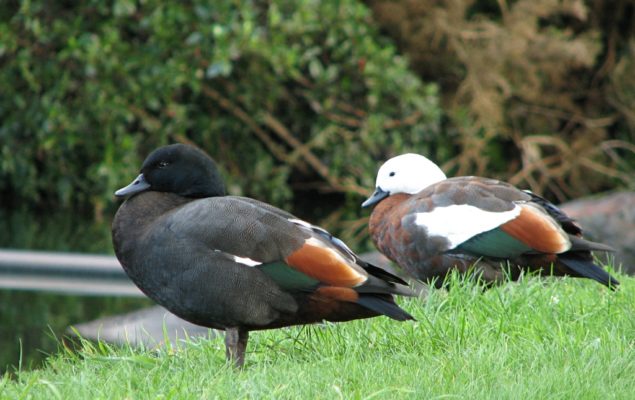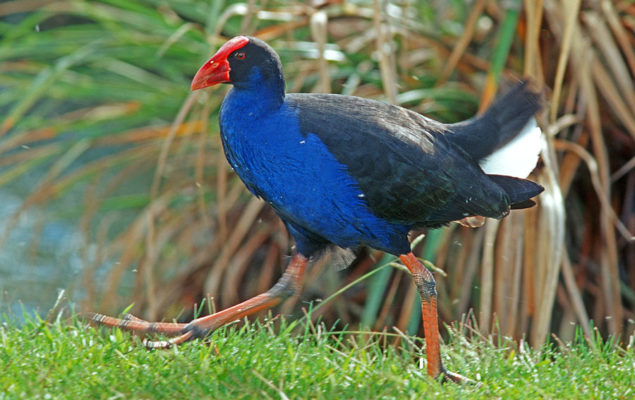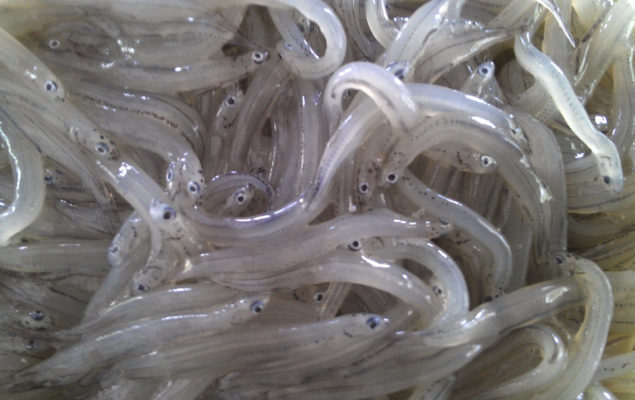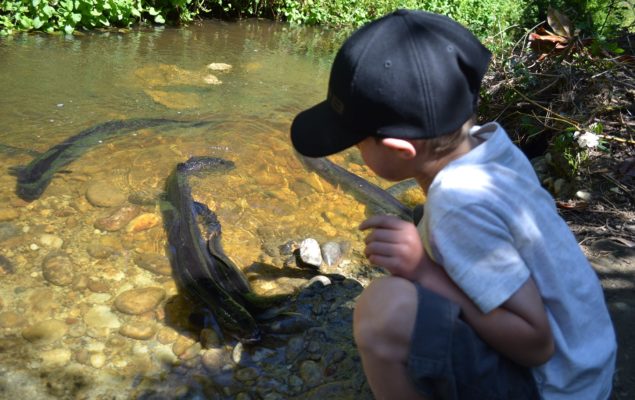Fantail (Pīwakawaka)
Known for its friendly ‘cheet cheet’ call and energetic flying antics, the aptly named fantail is one of the most common and widely distributed native birds on the New Zealand mainland.
It is easily recognized by its long tail which opens to a fan. It has a small head and bill and has two colour forms, pied and melanistic or black. The pied birds are grey-brown with white and black bands.
Tui (Tūī)
Tūī are common throughout New Zealand in forests, towns and on off-shore islands. They are adaptable and are found not only in native forests, bush reserves and bush remnants but also in suburban areas, particularly in winter if there is a flowering gum about.
These attractive birds can often be heard singing their beautiful melodies long before they are spotted. If you are fortunate to glimpse one you will recognise them by their distinctive white tuft under their throat, which contrasts dramatically with the metallic blue-green sheen to their underlying black colour.
Native Wood Pigeon (Kererū)
New Zealand’s native pigeon, also known as kererū, kūkū and kūkupa and wood pigeon, is the only disperser of large fruits, such as those of karaka and taraire.
The kererū is a large bird with irridescent green and bronze feathers on its head and a smart white vest.The noisy beat of its wings is a distinctive sound in our forests. The pigeon is found in most lowland native forests of the North, South and Stewart/Rakiura islands and many of their neighbouring islands.
Bellbird (Korimako)
Most New Zealanders can easily recognise the bellbird by its melodious song, which Captain Cook described as sounding ‘like small bells exquisitely tuned’.
Well camouflaged, the bellbird is usually heard before it is seen. Females are dull olive-brown, with a slight blue sheen on the head and a pale yellow cheek stripe. Males are olive green, with a purplish head and black outer wing and tail feathers.
Paradise Ducks (Pūtakitaki)
The paradise shelduck is New Zealand’s only shelduck, a worldwide group of large, often semi-terrestrial waterfowl that have goose-like features. Unusually for ducks, the female paradise shelduck is more eye-catching than the male; females have a pure white head and chestnut-coloured body, while males have a dark grey body and black head.
Paradise shelducks are commonly observed flying in pairs or grazing on pasture. They are very vocal birds, with males giving a characteristic ‘zonk zonk’, while females make a more shrill ‘zeek zeek’ while flying or as a warning to intruders.
Pūkeko
Pūkeko are probably one of the most recognised native birds in New Zealand with its distinctive colourings and habit of feeding on the ground. It is found all over New Zealand.
Commonly seen along marshy roadsides and low-lying open country, the bird’s range has increased with agricultural development. Unlike many other native birds, the pūkeko has adapted well to new habitats, such as grassed paddocks, croplands and even city parks, a necessity brought about by disappearing wetlands. However, the pūkeko is essentially a bird of swampy ground, lagoons, reeds, rushes and swamps.
Oystercatcher (Tōrea pango)
Oystercatchers are stocky birds with bright eye-rings and long colourful bills. Their diet is much more varied than their name implies. There are three species in New Zealand.
The pied oystercatcher or torea is the most common oystercatcher in New Zealand, numbering around 112,000 birds in 1994.The New Zealand subspecies (Haematopus ostralegus finschi) is the South Island pied oystercatcher or SIPO. It has a black head and upper surfaces, and a white belly.The variable oystercatcher (Haematopus unicolor, torea or toreapango) is found on rocky and sandy beaches. It is rare – there were around 3,500 birds in 1994, and they are found only in New Zealand.With a population of only 220 birds in 2004, the endemic Chatham Island oystercatcher (Haematopus chathamensis) is endangered.This species is confined to the Chatham Islands and South East and Pitt islands. They measure 48 centimetres and weigh 600 grams.
New Zealand Fur Seal (Kekeno)
New Zealand Fur Seal are the most common seals in New Zealand waters. They are very good swimmers and weaned pups will turn up almost anywhere around New Zealand. A Fur Seal pup tagged on the west coast of South Island has even been recorded in Australia. On land they sometimes become disoriented and have been found in unusual places such as back-yards, drains and streets.
Common Dolphin (Aihe)
Common dolphins found in New Zealand waters belong to the species now known as the short-beaked common dolphin. The colouration of this dolphin is very distinctive with a criss-cross or hour-glass type pattern centred on the flanks. Colours include purplish black, grey, white and yellowish tan. The dorsal fin is high with a concave hind edge. The head is low and smooth-sloping.
Little Blue Penguin (Kororā)
The world’s smallest penguin, little penguin (also known as little blue penguin) stand just over 25 cm and weigh around 1 kg. The plumage is slate-blue with a bright white belly. They are found on most of New Zealand’s coastline and in southern Australia.
They spend much of their time at sea hunting small fish, crustaceans and squid. Like all penguins they cannot fly, but their paddle-like flippers are excellent for ‘flying’ through the water.Little penguins forage for food up to 25 km offshore and 70 km from the colony.They can reach speeds of up to 6 kph underwater. Little penguins only come ashore under the cover of darkness and live underground in burrows, natural holes, or under human structures or buildings.
Whitebait (Inanga)
The small fish caught each spring by whitebaiters all around the country are actually the juveniles of five species of fish. They are banded Kokopu, Giant Kokopu, Inanga, Koaro and Shortjawed Kokopu.
These five are part of a group of fish called galaxiids (so called because of the patterns of their skin which look like a galaxy of stars) of which there are 20 species, the rest of which don’t migrate.
Those that escape the whitebait net grow into silvery, slender adults (about 9 cm long). They spawn in streamside vegetation, even rank exotic grasses are suitable.
Longfin Eels (Ōrea)
Longfin eels can be found throughout New Zealand. They live mainly in rivers and inland lakes but can be found in almost all types of waters, usually well inland from the coast.
They are legendary climbers and have made their way well inland in most river systems, even those with natural barriers. Elvers (young eels) swimming up river will climb waterfalls and even dams by leaving the water and wriggling over damp areas. It is not unheard of for an eel to climb a waterfall of up to 20 metres.
When eels begin life, they are a tiny one millimetre in length. During their life, they can grow up to two metres long.
Compared with many other fish, eels are slow growing – a longfin may grow only between 15-25mm a year. They can also live for many years. Large longfins have been estimated to be at least 60 years old.
The biggest eels are usually old females that have been slow to reach sexual maturity and, for reasons that are not yet understood, have not migrated to sea to breed.
